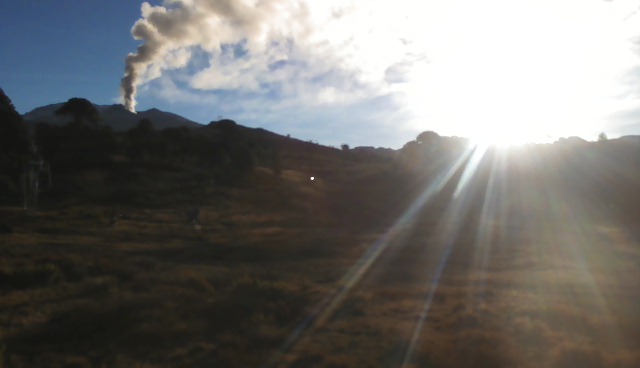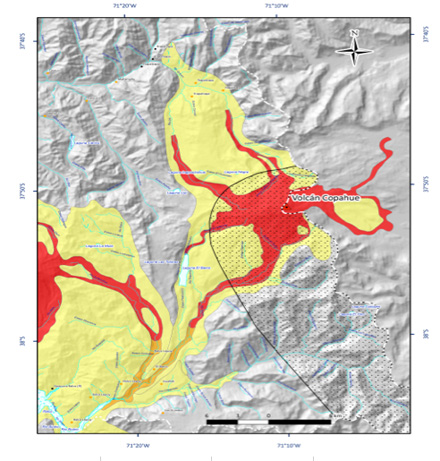Intense seismic swarm at Copahue volcano, Chile – Alert level raised to Red

Intense seismic swarm was recorded at Chile's Copahue volcano on May 26th with 356 low magnitude earthquakes related to magma movement per hour. Today, SERNAGEOMIN reported an average of 269 earthquakes per hour, with 6-8 seconds gap, and changed the status of the volcano from Orange to Red – an eruption is imminent or in progress.
Continuous volcanic tremor, an almost sure sign of eruption, has not yet been recorded.
National Emergency Office – ONEMI declared a Red Alert in the commune of Alto Biobío. More than 2000 people living in rural areas around the volcano will be evacuated. Schools in towns around the volcano are closed.
The report also states that the volcano has suffered inflationary deformation process by 10.5 cm / year, which slowed somewhat with the eruption of December 2012, and then continued up to 17.5 cm, which is considered high.
Citizens of Caviahue, Argentina, reported explosions and incandescence from volcano.
Volcanic hazard map of Copahue

Red – Hazard area (within 15 km) likely to be affected by lava and / or lahars.
Yellow – pyroclastic flows could extend its effects further afield (within 25 km) in case of larger eruption.
Stippled area – the area likely to be affected by ashfall thicknesses greater than 1 cm, located primarily on the east the volcano.
Image credit: SERNAGEOMIN
OVDAS/SERNAGEOMIN concludes (May 27, 2013):
The intensity and type of seismicity observed in recent days, in conjunction with the deformation of the volcanic building, suggest, with a high probability, that the rise of a magmatic body in the shallow layers of the volcano has entered a process of no return.
Extrusion of dome and associated phenomena such as explosive eruptions, with intensities greater than in December 2012, are highly probable. Such eruptions could generate pyroclastic flows and lahars. It is recommended to focus on a radius of 15 km around the active crater and on the banks of the rivers originating in the volcano.
The development process can last several weeks but can also occur anytime.
About Copahue
Volcán Copahue is an elongated composite cone constructed along the Chile-Argentina border within the 6.5 x 8.5 km wide Trapa-Trapa caldera that formed between 0.6 and 0.4 million years ago near the NW margin of the 20 x 15 km Pliocene Caviahue (Del Agrio) caldera. The eastern summit crater, part of a 2-km-long, ENE-WSW line of nine craters, contains a briny, acidic 300-m-wide crater lake (also referred to as El Agrio or Del Agrio) and displays intense fumarolic activity.
Acidic hot springs occur below the eastern outlet of the crater lake, contributing to the acidity of the Río Agrio, and another geothermal zone is located within Caviahue caldera about 7 km NE of the summit. Infrequent mild-to-moderate explosive eruptions have been recorded at Copahue since the 18th century. Twentieth-century eruptions from the crater lake have ejected pyroclastic rocks and chilled liquid sulfur fragments (GVP).
Last noticeable eruption of Copahue occurred in 2000. After that, the volcano experienced a first increase of activity in December 2012, and a second one in January 2013. No eruption followed and alert was lowered to Green in April before returning to Yellow soon after. On May 24th alert level was raised to Orange, and on May 27th to Red.
Sources/read more: SERNAGEOMIN, LaNacion, Eruptions Blog, VolcanoDiscovery
Featured image: Steam-ash plume from Copahue on May 24, 2013 (SERNAGEOMIN webcam)

Commenting rules and guidelines
We value the thoughts and opinions of our readers and welcome healthy discussions on our website. In order to maintain a respectful and positive community, we ask that all commenters follow these rules:
We reserve the right to remove any comments that violate these rules. By commenting on our website, you agree to abide by these guidelines. Thank you for helping to create a positive and welcoming environment for all.